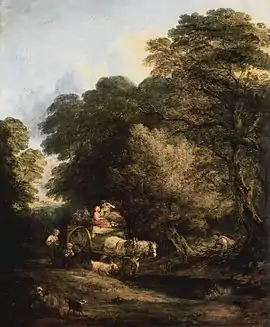Gainsborough Lane
Gainsborough Lane is a rural road in the South East Area, Ipswich which has been noted for its charm since the nineteenth century. In 1888 John Ellor Taylor, curator of Ipswich Museum, described it as the "dearest walk" available locally for Ipswich people.[1]: 121

The Market Cart, a painting by Thomas Gainsborough depicting Gainsborough Lane (1786-1787)
In 1901 William Dutt wrote:
- "When Gainsborough resided in Ipswich much of his time was spent on the banks of the Orwell, and a lane not far from the town, now known as Gainsborough's Lane, is depicted in his picture The Market Cart, which is in the National Gallery. This lane owes its beauty to its magnificent oaks, which interlace their branches above the turf-bordered footpath leading to the Priory Farmhouse in which Margaret Catchpole was employed as a domestic servant. This house was formerly an Augustinian monastery".[2]
It proved a popular topic for local artists in the late nineteenth century such as John Postle Heseltine[3] and Henry George Todd.[4]
Gainsborough Lane leads from Pipers Vale to Priory Farm, once the workplace of Margaret Catchpole.[5] Nowadays the Orwell Bridge crosses over it.[6]
Gainsborough Lane in art
_by_John_Postle_Heseltine.png.webp) 1874 by John Postle Heseltine
1874 by John Postle Heseltine 1887 by Henry George Todd
1887 by Henry George Todd
References
- Taylor, James Ellor (1888). In and About Ancient Ipswich. Norwich: Jarrold & Sons.
- Dutt, William A. (1901). Highways and Byways in East Anglia (PDF). London: McMillan and Son. Retrieved 12 November 2022.
- Heseltine, John Postle. "John Postle Heseltine – Gainsborough Lane Ipswich – Rare Antique British Etching". eBay. Retrieved 28 July 2021.
- "Gainsborough Lane Ipswich by Henry GeorgeTodd". www.artnet.com. Artnet. Retrieved 28 July 2021.
- Wright, Pip. "Gainsborough Lane". pipwright.com. Pip Wright. Retrieved 28 July 2021.
- Twinch, Carol A. (2006). Ipswich. Derby: Breedon. ISBN 1859835015.
This article is issued from Wikipedia. The text is licensed under Creative Commons - Attribution - Sharealike. Additional terms may apply for the media files.